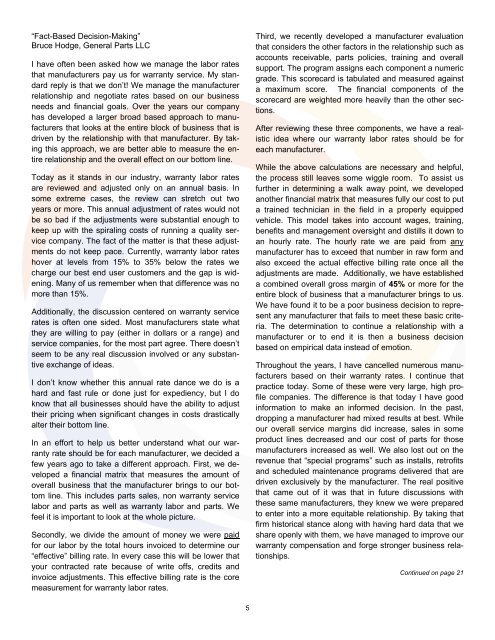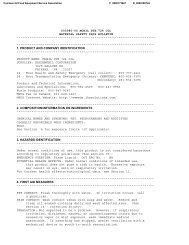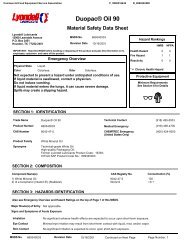On Target
mar april 2008.pub - CFESA
mar april 2008.pub - CFESA
- No tags were found...
You also want an ePaper? Increase the reach of your titles
YUMPU automatically turns print PDFs into web optimized ePapers that Google loves.
“Fact-Based Decision-Making”<br />
Bruce Hodge, General Parts LLC<br />
I have often been asked how we manage the labor rates<br />
that manufacturers pay us for warranty service. My standard<br />
reply is that we don’t! We manage the manufacturer<br />
relationship and negotiate rates based on our business<br />
needs and financial goals. Over the years our company<br />
has developed a larger broad based approach to manufacturers<br />
that looks at the entire block of business that is<br />
driven by the relationship with that manufacturer. By taking<br />
this approach, we are better able to measure the entire<br />
relationship and the overall effect on our bottom line.<br />
Today as it stands in our industry, warranty labor rates<br />
are reviewed and adjusted only on an annual basis. In<br />
some extreme cases, the review can stretch out two<br />
years or more. This annual adjustment of rates would not<br />
be so bad if the adjustments were substantial enough to<br />
keep up with the spiraling costs of running a quality service<br />
company. The fact of the matter is that these adjustments<br />
do not keep pace. Currently, warranty labor rates<br />
hover at levels from 15% to 35% below the rates we<br />
charge our best end user customers and the gap is widening.<br />
Many of us remember when that difference was no<br />
more than 15%.<br />
Additionally, the discussion centered on warranty service<br />
rates is often one sided. Most manufacturers state what<br />
they are willing to pay (either in dollars or a range) and<br />
service companies, for the most part agree. There doesn’t<br />
seem to be any real discussion involved or any substantive<br />
exchange of ideas.<br />
I don’t know whether this annual rate dance we do is a<br />
hard and fast rule or done just for expediency, but I do<br />
know that all businesses should have the ability to adjust<br />
their pricing when significant changes in costs drastically<br />
alter their bottom line.<br />
In an effort to help us better understand what our warranty<br />
rate should be for each manufacturer, we decided a<br />
few years ago to take a different approach. First, we developed<br />
a financial matrix that measures the amount of<br />
overall business that the manufacturer brings to our bottom<br />
line. This includes parts sales, non warranty service<br />
labor and parts as well as warranty labor and parts. We<br />
feel it is important to look at the whole picture.<br />
Secondly, we divide the amount of money we were paid<br />
for our labor by the total hours invoiced to determine our<br />
“effective” billing rate. In every case this will be lower that<br />
your contracted rate because of write offs, credits and<br />
invoice adjustments. This effective billing rate is the core<br />
measurement for warranty labor rates.<br />
Third, we recently developed a manufacturer evaluation<br />
that considers the other factors in the relationship such as<br />
accounts receivable, parts policies, training and overall<br />
support. The program assigns each component a numeric<br />
grade. This scorecard is tabulated and measured against<br />
a maximum score. The financial components of the<br />
scorecard are weighted more heavily than the other sections.<br />
After reviewing these three components, we have a realistic<br />
idea where our warranty labor rates should be for<br />
each manufacturer.<br />
While the above calculations are necessary and helpful,<br />
the process still leaves some wiggle room. To assist us<br />
further in determining a walk away point, we developed<br />
another financial matrix that measures fully our cost to put<br />
a trained technician in the field in a properly equipped<br />
vehicle. This model takes into account wages, training,<br />
benefits and management oversight and distills it down to<br />
an hourly rate. The hourly rate we are paid from any<br />
manufacturer has to exceed that number in raw form and<br />
also exceed the actual effective billing rate once all the<br />
adjustments are made. Additionally, we have established<br />
a combined overall gross margin of 45% or more for the<br />
entire block of business that a manufacturer brings to us.<br />
We have found it to be a poor business decision to represent<br />
any manufacturer that fails to meet these basic criteria.<br />
The determination to continue a relationship with a<br />
manufacturer or to end it is then a business decision<br />
based on empirical data instead of emotion.<br />
Throughout the years, I have cancelled numerous manufacturers<br />
based on their warranty rates. I continue that<br />
practice today. Some of these were very large, high profile<br />
companies. The difference is that today I have good<br />
information to make an informed decision. In the past,<br />
dropping a manufacturer had mixed results at best. While<br />
our overall service margins did increase, sales in some<br />
product lines decreased and our cost of parts for those<br />
manufacturers increased as well. We also lost out on the<br />
revenue that “special programs” such as installs, retrofits<br />
and scheduled maintenance programs delivered that are<br />
driven exclusively by the manufacturer. The real positive<br />
that came out of it was that in future discussions with<br />
these same manufacturers, they knew we were prepared<br />
to enter into a more equitable relationship. By taking that<br />
firm historical stance along with having hard data that we<br />
share openly with them, we have managed to improve our<br />
warranty compensation and forge stronger business relationships.<br />
Continued on page 21<br />
5








